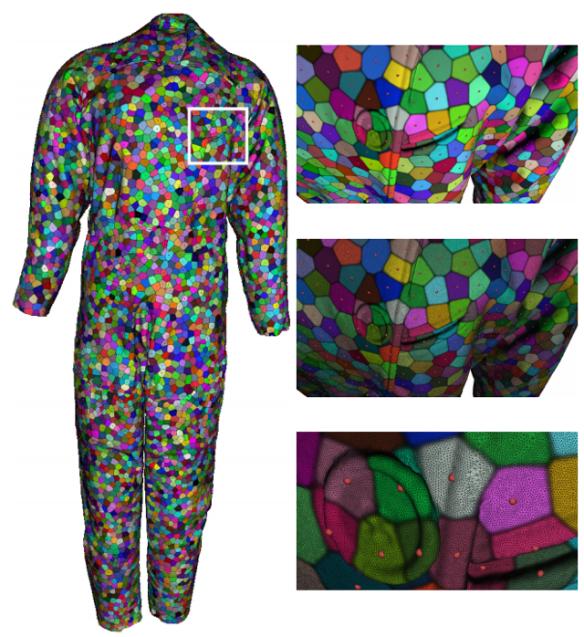
Millimeter Waves: Innovating the Last Mile Internet Connection

Amelia Earhart's Flight Suit (10M?) with 10 000 seeds, the resulting cells are visualized in different colors. A close-up of the cell distribution (top row) and the underlying mesh (middle and bottom rows) reveals small scale geometric complexity (pocket fold, button fold) that can successfully be processed with our computationally- and memory efficient approach.)
Courtesy: SIGGRAPH ASIA
“When we look at how natural tessellation occurs in nature, the individual cells grow simultaneously, and each individual cell does not necessarily know who are its neighboring cells nor their location or coordinates,” explains lead author of the work, Rhaleb Zayer, researcher at Max Planck Institute for Informatics in Saarbrücken, Germany.
Cells represent the shape or tiles that comprise intricate tessellation patterns. “To capture this behavior, we need to adopt an intrinsic view of the problem and depart from the widely adopted extrinsic perspective which requires full knowledge of all individual cell interactions and locations.”
Typically, researchers have turned to the Voronoi model to mimic such repeat surface patterns. In mathematics, A Voronoi diagram partitions planes in a pattern based on the distances between points.
Efforts at extending the same idea to surfaces are hampered by the extensive costs of accurate distance measurements, bookkeeping and intersection computations.
In this new work, researchers simplify the creation of natural tessellations on surface meshes by dropping the assumption that regions need to be separated by lines.
Instead, they have developed a method that takes into account region boundaries in the pattern as narrow bands, which are not necessarily straight, and model the partition as a set of smooth functions layered over the surface.
Their method relies mainly on basic sparse linear algebra kernels, i.e. multiplication and addition, readily available, as they are the cornerstone of modern numerical computing.
“In this way, we provide small, concise, humanly readable and most importantly, platform-independent parallel code,” notes Zayer.
“Observing the progress made in parallelizing existing serial Voronoi diagram codes over the last two decades, the performance gains achieved by our proposed method are very considerable,” adds Markus Steinberger, coauthor of the work and an assistant professor at Graz University of Technology in Austria.
Zayer, Steinberger and their collaborators, which include Hans-Peter Seidel at Max Planck Institute for Informatics, and Daniel Mlakar at Graz University of Technology, will present their novel method at SIGGRAPH Asia 2018 in Tokyo 4 December to 7 December.
The annual conference features the most respected technical and creative members in the field of computer graphics and interactive techniques, and showcases leading edge research in science, art, gaming and animation, among other sectors.
In their paper, “Layered Fields for Natural Tessellations on Surfaces,” the authors successfully demonstrate their new method on several large-scale test cases beyond the capabilities of state-of-the-art.
They were able to show that their method is applicable to highly detailed models, such as the 3D Model of the famed pilot Amelia Earhart's flight suit, encompassing ten million facets. Tessellations on the scan of the highly ornamented historic Pergolesi Side Chair showcase 30 million facets processed fully and efficiently on a single modern graphics-processing unit, aka, GPU. Despite the simplicity of the algorithm, the researchers say their solution proved to be comprehensive with minimal requirements.
In future work, Zayer and team hope to add the function of interactively editing tessellations using their framework. This feature could be aimed at designers and architects new to 3D printing applications and modeling. The researchers also intend to extend this work to higher dimensions and to the treatment of other metrics.
About SIGGRAPH Asia 2018
The 11th ACM SIGGRAPH Conference and Exhibition on Computer Graphics and Interactive Techniques in Asia (SIGGRAPH Asia 2018) will be held in Tokyo, Japan at the Tokyo International Forum from 4 to 7 December 2018. The annual event held in Asia attracts the most respected technical and creative people from all over the world who are excited by research, science, art, animation, gaming, interactivity, education and emerging technologies.
The four-day conference will include a diverse range of juried programs, such as the Art Gallery, Computer Animation Festival, Courses, Emerging Technologies, Posters, Technical Briefs, Technical Papers and Virtual & Augmented Reality. A three-day exhibition held from 5 to 7 December 2018 will offer a business platform for industry players to market their innovative products and services to the computer graphics and interactive techniques professionals and enthusiasts from Asia and beyond. For more information, please visit http://sa2018.
About ACM SIGGRAPH
The ACM Special Interest Group on Computer Graphics and Interactive Techniques is an interdisciplinary community interested in research, technology, and applications in computer graphics and interactive techniques. Members include researchers, developers, and users from the technical, academic, business, and art communities. ACM SIGGRAPH enriches the computer graphics and interactive techniques community year-round through its conferences, global network of professional and student chapters, publications, and educational activities. For more information, please visit http://www.












